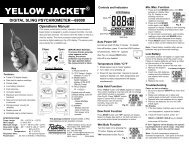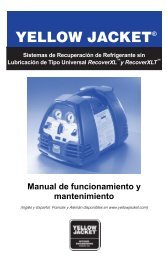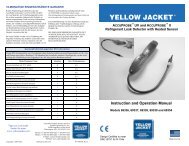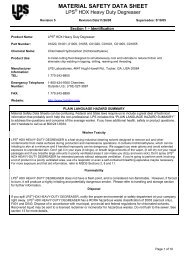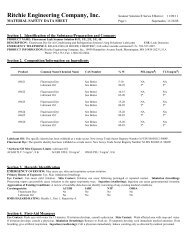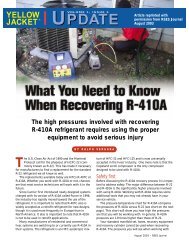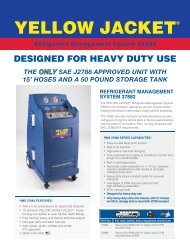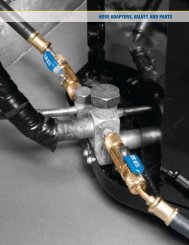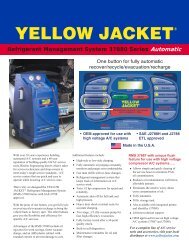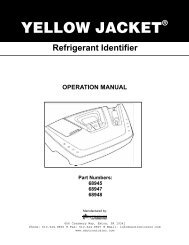YELLOW JACKET High Vacuum Pump Oil 1 - HVAC-Talk
YELLOW JACKET High Vacuum Pump Oil 1 - HVAC-Talk
YELLOW JACKET High Vacuum Pump Oil 1 - HVAC-Talk
Create successful ePaper yourself
Turn your PDF publications into a flip-book with our unique Google optimized e-Paper software.
<strong>YELLOW</strong> <strong>JACKET</strong>® <strong>High</strong> <strong>Vacuum</strong> <strong>Pump</strong> <strong>Oil</strong><br />
Ingestion<br />
Chronic Health Effects<br />
Summary<br />
Conditions Aggravated<br />
by Exposure<br />
Target Organs<br />
Carcinogenic Potential<br />
If swallowed, large volumes of material can cause generalized depression, headache,<br />
drowsiness, nausea, vomiting and diarrhea. Smaller doses can cause a laxative effect. If<br />
aspirated into the lungs, liquid can cause lung damage.<br />
This product contains a petroleum-based mineral oil. Prolonged or repeated skin contact<br />
can cause mild irritation and inflammation characterized by drying, cracking, (dermatitis) or<br />
oil acne. Repeated or prolonged inhalation of petroleum-based mineral oil mists at<br />
concentrations above applicable workplace exposure levels can cause respiratory irritation or<br />
other pulmonary effects.<br />
Disorders of the following organs or organ systems that may be aggravated by significant<br />
exposure to this material or its components include: Skin<br />
May cause damage to the following organs: skin<br />
This product is not known to contain any components at concentrations above 0.1% which<br />
are considered carcinogenic by OSHA, IARC or NTP.<br />
OSHA Hazard Classification is indicated by an "X" in the box adjacent to the hazard title. If no "X" is present,<br />
the product does not exhibit the hazard as defined in the OSHA Hazard Communication Standard (29 CFR<br />
1910.1200).<br />
OSHA Health Hazard Classification<br />
OSHA Physical Hazard Classification<br />
Irritant<br />
Sensitizer<br />
Combustible<br />
Explosive<br />
Pyrophoric<br />
Toxic<br />
<strong>High</strong>ly Toxic<br />
Flammable<br />
Oxidizer<br />
Water-reactive<br />
Corrosive<br />
Carcinogenic<br />
Compressed Gas<br />
Organic Peroxide<br />
Unstable<br />
SECTION 4. FIRST AID MEASURES<br />
Take proper precautions to ensure your own health and safety before attempting rescue or providing first aid.<br />
For more specific information, refer to Exposure Controls and Personal Protection in Section 8 of this MSDS.<br />
Inhalation<br />
Eye Contact<br />
Skin Contact<br />
Ingestion<br />
Notes to Physician<br />
Vaporization is not expected at ambient temperatures. This material is not expected to cause<br />
inhalation-related disorders under anticipated conditions of use. In case of overexposure,<br />
move the person to fresh air.<br />
Check for and remove contact lenses. Flush eyes with cool, clean, low-pressure water while<br />
occasionally lifting and lowering eyelids. Seek medical attention if excessive tearing, redness,<br />
or pain persists.<br />
If burned by hot material, cool skin by quenching with large amounts of cool water. For<br />
contact with product at ambient temperatures, remove contaminated shoes and clothing.<br />
Wipe off excess material. Wash exposed skin with mild soap and water. Seek medical<br />
attention if tissue appears damaged or if pain or irritation persists. Thoroughly clean<br />
contaminated clothing before reuse. Clean or discard contaminated leather goods. If material<br />
is injected under the skin, seek medical attention immediately.<br />
Do not induce vomiting unless directed to by a physician. Do not give anything to drink unless<br />
directed to by a physician. Never give anything by mouth to a person who is not fully<br />
conscious. If significant amounts are swallowed or irritation or discomfort occurs, seek<br />
medical attention immediately.<br />
SKIN: In the event of injection in underlying tissue, immediate treatment should include<br />
extensive incision, debridement and saline irrigation. Inadequate treatment can result in<br />
ischemia and gangrene. Early symptoms may be minimal.<br />
INGESTION: The viscosity range of the product(s) represented by this MSDS is greater than<br />
100 SUS at 100°F. Careful gastric lavage may be considered to evacuate large quantities of<br />
material.<br />
MSDS No. 634104001<br />
Revision Date 8/24/2009<br />
Continued on Next Page Page Number: 2



